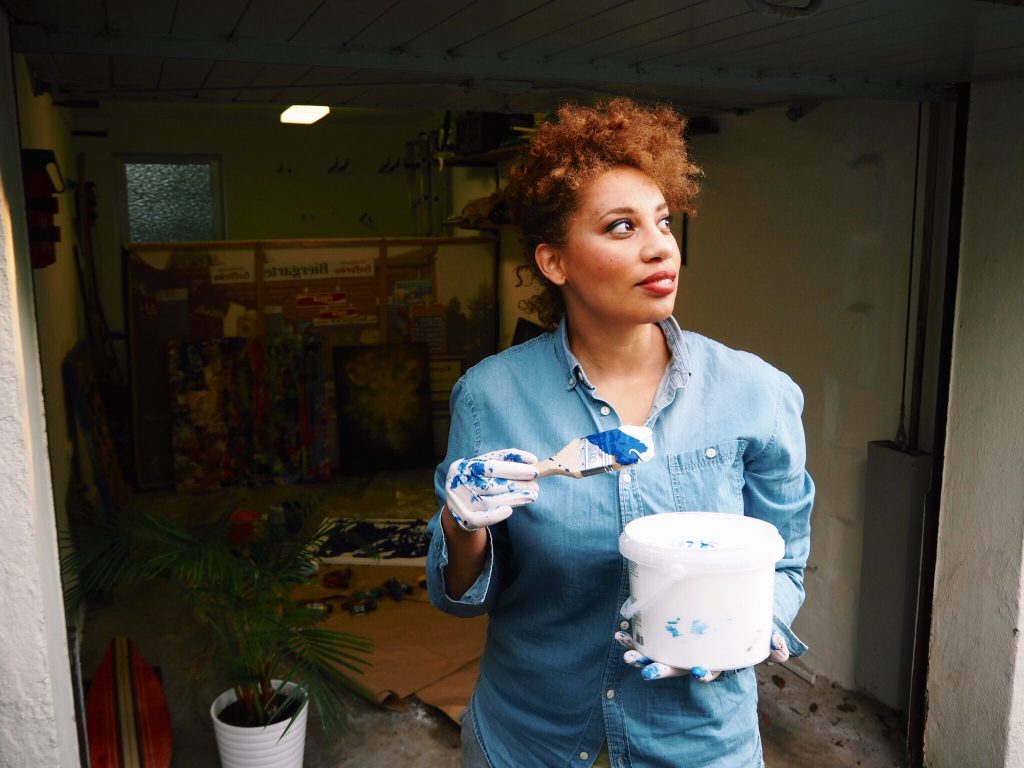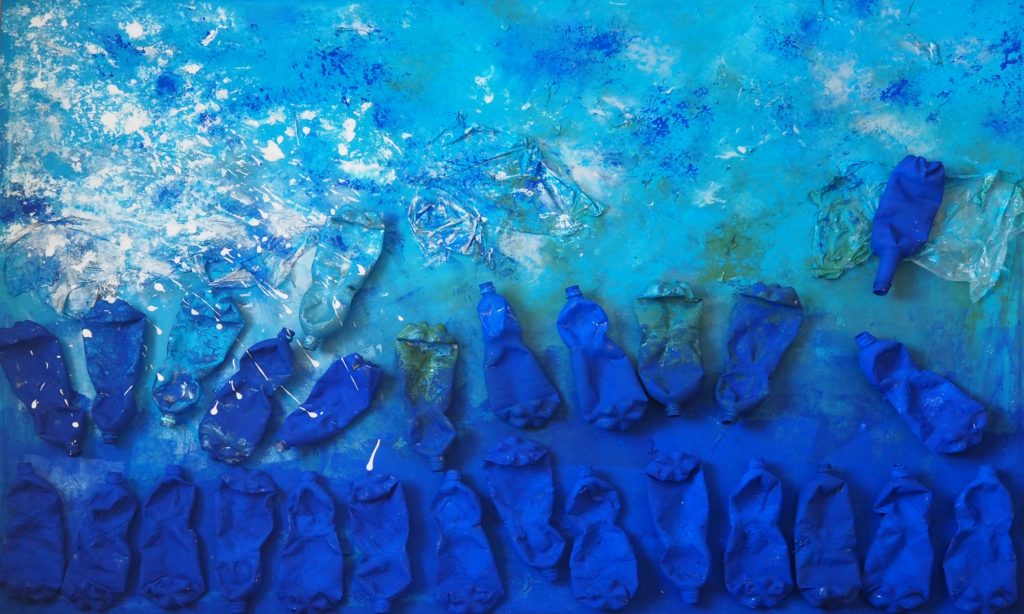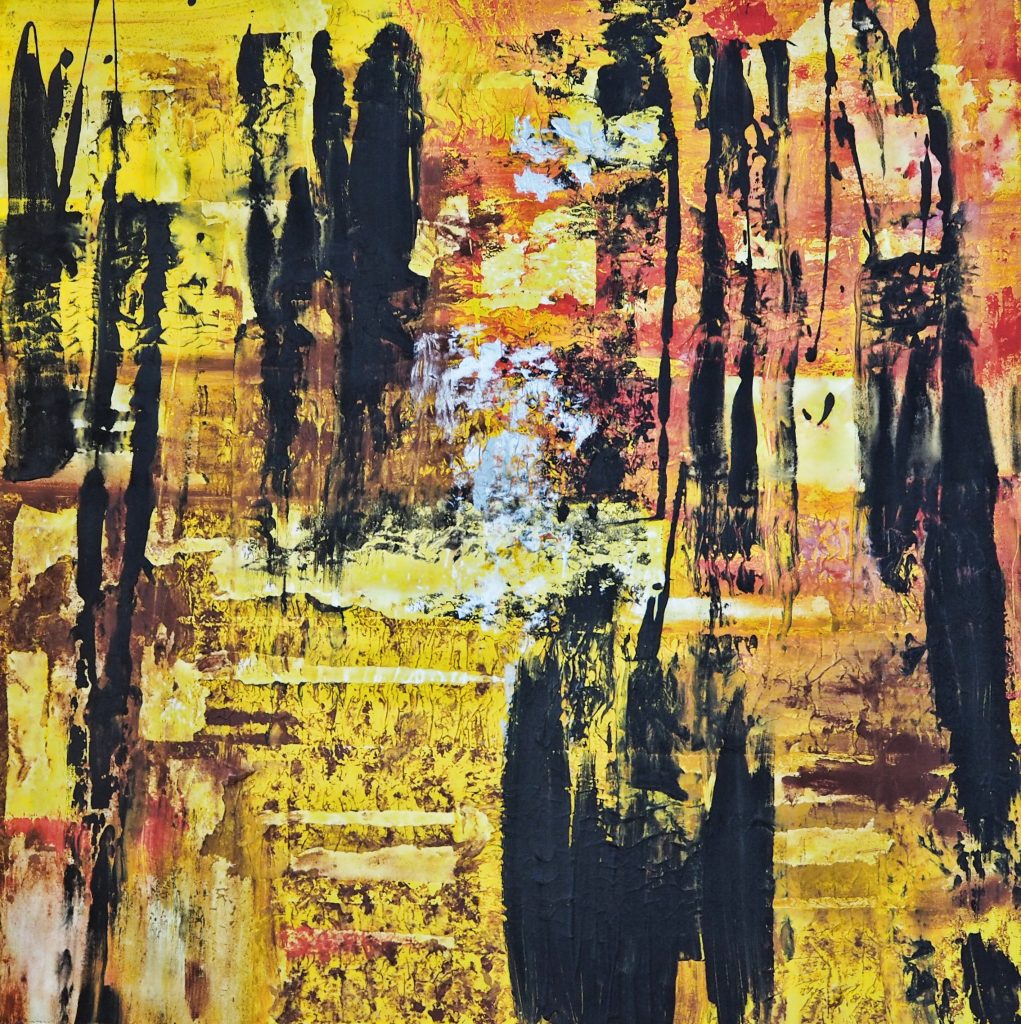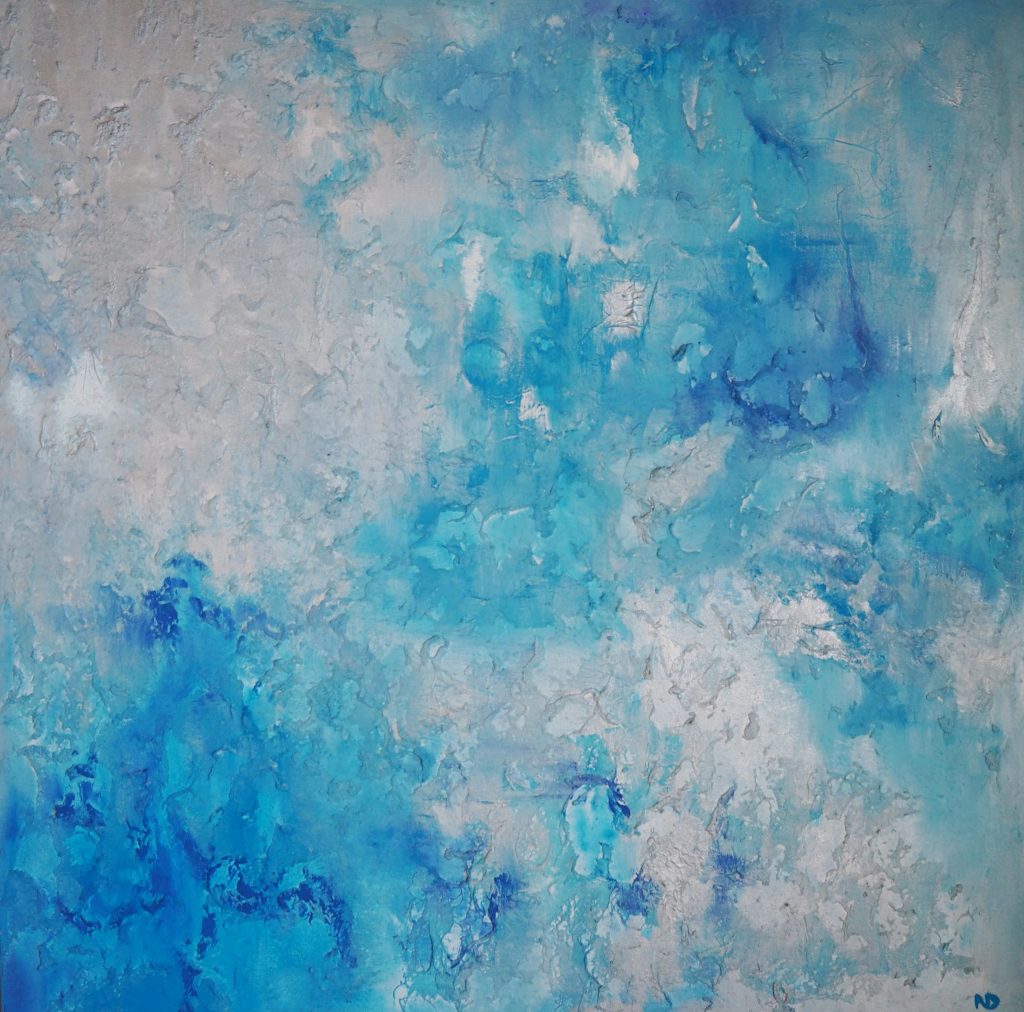An enriching conversation with Nina Lukisa on her multicultural background, creating works with existential subjects and finding unity in differences.

Nina Lukisa is a German contemporary artist who finds her inspiration in subjects that originate from her extensive cultural background, architecture, philosophy, science, music, and topics which create social interactions. With a degree in political science, the self-taught artist decided to follow her passion by pursuing a professional career as a visual artist. Her work explores a variety of characteristics and techniques, but with a style that is recognisable by the application of dissimilar materials like plastic, wood, and textile. There is a buildup of several layers of paper and other ephemera materials that create depth and impact on the varying qualities of her paintings.
In this conversation, I speak with Lukisa about her practice, cultural background, and the constant search for and experimentation with distinct materials to realize paintings that are laden with existential subjects which affect us globally. — Jude Anogwih
Jude Anogwih: I would like to start this conversation by looking at sources that motivate you. You have an amazing family background that has enriched you with experiences and influences both personally and artistically. How do these encounters inspire your work as a painter?
Nina Lukisa: My multicultural background taught me to be curious, kind, happy, and open-minded by developing an attitude that looks at diversity as a source full of potential. It is true that potential is revealed when we deal with it in a responsible way. Only then do we learn to benefit from the different attitudes and perspectives it encompasses. It felt very liberating, privileged and creative to grow up like this. The privilege that I also had was the freedom to create my own philosophy of life. I could cherry-pick out of the different influences. These experiences are always reflected in my works; I combine different materials to create a unity. I embody several layers in one overall layer. It is always about the combination of differences to unity.
JA: Let’s talk more about your multicultural background and having roots in Zambia, former Yugoslavia and Germany. Seemingly, it is the basis of the symbolic ‘combination of differences to unity’ you described. Do you see yourself as a reflection of these representations? How do these multicultural dimensions of you resonate in your work and practice?
NL: My multiracial identity forced me to think deeply about the concept of heritage: what makes us who we are, which traits manifest? It is challenging when you don’t fit into a box. Especially, when your influences are as diverse as mine. But the best way to deal with these challenges is as the saying goes, “when life gives you lemons, make lemonade”. My lemonade is to take all the benefits and the beautiful aspects of it and merge them to unity. This process is reflected in my work through the materials I work with, through the techniques I apply, and through the topics I choose.

JA: You’re right, I see such layers of metaphorical moments in your work. Breath and Infinity are examples of paintings that are intuitively embodying. I assume that as you think of nature and human activities, you equally put to action your sentiments to bring to life, to resuscitate… What are you bidding to restore with your painting?
NL: The clash of the known and the unknown have always been fascinating phenomena to me. Maybe because these two strains are a part of human nature. There are people who are afraid of the unknown and then there are others who are thrilled by it. There is so much energy that results out of this encounter which one can use either in a productive or disruptive way. From an artistic point of view, both ways can be used meaningfully to coin a message. The painting Infinity demonstrates that in a very dominant and intrusive manner. The plastic bottle is a typical everyday item that we use, but what happens when this alleged known object is used in a way that we don’t expect? It causes irritation. These tiny moments of irritation contain the power to change the observer’s perspective and make him or her rethink the purpose of the alleged known item (in this case the environmental pollution caused by plastic bottles). For the painting Breath I chose to follow a slightly different aspect of the characterized clash. Here, the known is obvious and the clash seems to be non-existent. Breath is pointing simultaneously at three conditions of the essential natural elements: the sea, the sky and the outer space. Although these three elements are very different, they share a common reflection of human desire – which are feelings of freedom, enlightenment, and inner peace. All these experiences can lead to an emotional state of deeper self-consciousness, self-love, and happiness. It is a meditative state of being this painting expresses. My aim was to create a painting that will be useful in an everyday life. A painting that can constantly and positively contribute to the state of happiness.
Although these three elements are very different, they share a common reflection of human desire – which are feelings of freedom, enlightenment, and inner peace.
JA: How does your choice of material and work process help establish the unity and happiness that you strive for?
NL: In my works, the technique of layers is always omnipresent. I mostly work with paper, glass stones, plastic, wood and textile. The layers represent the external and internal aspects of how we perceive our world and each other. By revealing these layers, a cathartic journey opens up. The combination of these different materials builds a unity. When applying it, I enjoy working more with my hands than brushes, because I like the physical process of it. There is always an art of a vivid easiness that my paintings transport. I want people to feel delighted and happy when they watch the painting.
JA: Looking at your paintings, I wonder how each work is realized – the tactile quality, layered references and the density of color and some found matters all come together consciously, thoughtfully. Tell me about your work process. Do you draw out your forms before painting them?
NL: After deciding on a topic, I start to draw in an imaginary way. First, everything is worked out in my mind. It can take hours, days or sometimes months until the imaginative painting is finished. Then I am ready to bring the imagination to life. Most of the time, it goes very fast because the preparation has already been done. Naturally, during the process of implementation, details occur which haven’t been planned initially. The painting process takes its own course, but the concept of it is pretty much the one I’ve envisioned before. My mind is in a constant state of painting which is why I enjoy being inspired, because I can incorporate it instantly in my works.
JA: There are traces of physical and cultural presence in works like Africa – The Raw Beauty, Miami, Rome, Midnight in the City and Matador, amongst others. They bear an energetic imprint. What experiential stories shaped these paintings?
NL: I have always been a very sensitive person. I used to experience it more as a burden then as a gift. Over time, I have come to understand that this characteristic of mine is fundamental to my being as an artist. It helps me to sense the core of the topics that I assume important for my work. The paintings you mentioned all have one thing in common: they deal with the societal fabric of modern life. Each of them represents different aspects of it. So for example, Africa – The Raw Beauty – is about staying connected with yourself, Miami deals with different influences for which the city is known, Rome is about past and present, Midnight in the City puts the lifestyle of a typical party lover into the center, Matador is about the predominant feeling of dissonance that shows up when you fail to master the challenges of modern life. Through my paintings I want to stress the obvious aspects to make the topics easily accessible to everyone. I believe that it fosters the mutual understanding when people can experience and feel that they share a common ground.
Abstract painting demands conversation and challenges an observer’s perspective. …Even in cases where you don’t like what you see the challenge to deal with it is always there.

JA: I’m intrigued by the concept of a ‘combination of differences to a unity’. In one perspective, it brings to my mind the American artist, Mel Chin who observed that ”art is not static, it is catalytic…art is not just a language, it is useful, it makes things function…it has a critical relationship in society…” You paint “to contribute to the state of happiness” and you also make paintings that “will be useful in everyday life”. Considering the sociopolitical divide on issues of environmental conservation/preservation, do you see art and artists being more vocal and pushing for convincing change in global understanding of nature, climate change and the environment?
NL: The problems we are facing today as a society, on a local and global level, is very complex. Interdependences between countries have been reinforced throughout the years by globalization. This complexity creates more problems but at the same time it offers more options on how problems can be solved. The outcome depends on how we approach that. The human race is constantly in change. Finally, the evolution never stops. The more important question is what did we learn from the past and what are our visions for the future? I do believe that artists can cause convincing changes with their art. There lies power in the ability to provide messages in a way that is engaging and emotionally touching. Every artist speaks his or her own language and yet they are able to make their message understandable to bigger audiences and by this to establish a sense of community. They are bridge builders, who inspire others to take a look more deeply at all the different shadows that life has to offer. This ability makes them a true translator of an invisible world, filled with inspiring insights. Creativity isn’t something that can be analyzed100%. A part of it will always remain unexplained. Even to the artist himself.
JA: That’s interesting. Should the artistic message that is engaging and emotionally touching fail, do you see a more radical approach by the artist? Do you see a seemingly radical use of art to ensure that the message on climate change and protecting our planet makes more meaning to one and all?
NL: In this context, I think that every artist will always fail with each of his works. You can’t reach everyone. That is something we must accept. I believe that is important to stay true to yourself and to beware of your individual artistic integrity. If an artist opts for a more radical approach, then this should be done because it is part of the developed concept rather than out of the strategical reason. Otherwise the artist will make himself dependent on people’s response, which in return would deem or even kill his creativity.

JA: Why do you opt for abstract painting rather than representational/figurative art forms?
NL: I like the interpretive content that abstract art entails. It challenges the observer to analyze the painting, since the concept of it is hidden at first glance. And even more important is that through the involvement of the audience the painting receives additional meanings. I want to know what the observer brings in. Abstract painting demands conversation and challenges an observer’s perspective. I like this kind of conversations, because they are vibrant and intense. Even in cases where you don’t like what you see the challenge to deal with it is always there. It keeps the paintings’ message dynamic and alive.
JA: Can you briefly share an instance from any past exhibition(s), maybe Genius Loci. How do you think people experienced and shared in the artistic knowledge that this or any other exhibition made available?
NL: The dominant response was that people really started to engage with the paintings by sharing their first impressions, information that surprised them, and even personal stories that were connected to the presented topics. They appreciated the lightness with which some of the topics were conveyed and they started to imagine how their favorite painting would affect them in their own personal space. That showed me that the communication between the paintings, audiences, and I was real, vivid and authentic.
JA: When you’re not painting, what else do you fill your time with?
NL: I like to explore the world around me, whether by travelling, reading or spending time with people that I love. I love to be inspired and hopefully I am able to inspire people around me.
JA: Now to my favorite part, I’m currently enjoying this book Folkloristics: An Introduction by Robert A. Georges and Michael Owen Jones. It is a study of folklore and folklore methodologies. The authors describe the pervasiveness of folklore, including its uses in basically a variety of cultures, literature, films, television, cartoons, comic strips, advertising, and other media. The book further looks at over 400 examples from Africa, North America, Latin America, Russia, Philippines, Japan, and Europe. May I ask what book(s) you are currently reading or have read recently?
NL: …very inspiring! Sounds interesting, also because of the topic’s complexity. Usually, I read several books at once. Currently I am reading: The Art of Thinking Clearly by Rolf Dobelli, The Alchemist by Paolo Coelho, (which is a classic novel that is always worth a re-read), the autobiographical book Herkunft (which means ancestry) by Saša Stanišić, and Oprah Winfrey’s new book The Path Made Clear.
To find out more about Nina Lukisa, visit www.ninalukisa.com or her Instagram: @ninalukisa.
Anogwih is a visual artist/artist-curator. He’s an MFA candidate at the University of Alabama, Tuscaloosa, USA.




